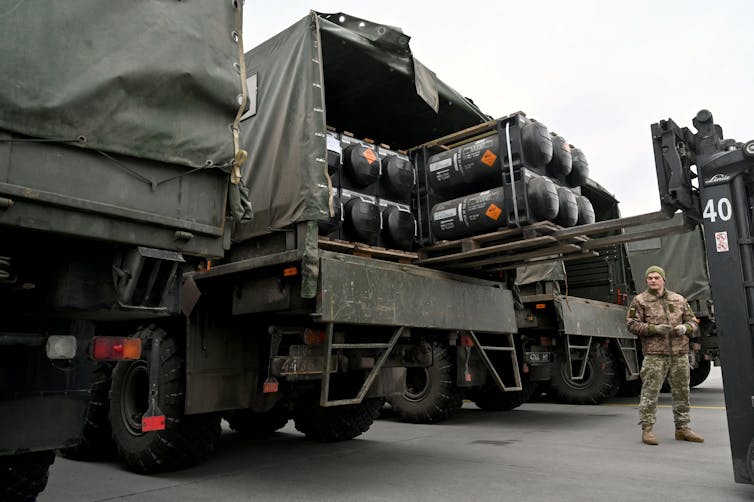5 things to know about US aid to Ukraine

By Jessica Trisko Darden, Virginia Commonwealth University
From the start of the Russian invasion of Ukraine on Feb. 24, 2022, the U.S. government has been a staunch supporter of Ukraine’s war effort. The Biden administration has repeatedly produced emergency spending packages to support the Ukrainian government and military. That funding has so far amounted to US$113 billion.
But public opinion polls suggest that Americans’ support for Ukraine was waning even before Hamas’ Oct. 7, 2023, terrorist attack on Israel and the ensuing Israel-Hamas war drew international attention away from Ukraine.
Political scientist Jessica Trisko Darden, author of “Aiding and Abetting: U.S. Foreign Assistance and State Violence,” explains how recent efforts by the Republican-controlled House of Representatives to hold up aid to Ukraine reflects the perception that the U.S. is spending too much money on Ukraine at the expense of other domestic priorities, such as increased security at the U.S. southern border.
1. How much aid has the US provided to Ukraine so far?
So far, the U.S. has approved about $113 billion in aid to Ukraine through four supplemental emergency appropriations, which are a way of requesting funds outside of the normal budgetary process. The majority of this aid has been for military purposes.
The more than $62.3 billion provided in military assistance includes at least $23.5 billion worth of U.S. weapons from the Department of Defense. In contrast, about $3 billion has been for humanitarian assistance.
Advocates for increased U.S. aid have pointed out that much of the military assistance to Ukraine actually supports the U.S. defense industry. Those advocates also argue that the war in Ukraine is devastating Russia’s military assets, and the current approach is much cheaper than facing an expansionist Russia.

But critics argue that the unprecedented amounts of U.S. military aid to Ukraine are draining U.S. military stockpiles and potentially degrading military readiness.
Others have called for additional oversight for aid to Ukraine, given the country’s history of government corruption.
2. What aid is the Biden administration currently requesting for Ukraine?
The current request before the House includes $105 billion in security assistance for Ukraine, Israel, Taiwan and the U.S. southern border, with more than $61 billion of the package for Ukraine.
In comparison, $6.4 billion is being requested for U.S. border operations.
This aid package is separate from the defense appropriations bill passed by the Senate on Dec. 13 and the House on Dec. 14, which includes $600 million in military aid for Ukraine and funding for the creation of a special inspector general to oversee aid to Ukraine. That bill awaits President Joe Biden’s signature.
Voting on the special funding request was initially delayed by the ouster of former House Speaker Kevin McCarthy. But current Speaker Mike Johnson has done little to advance a vote, despite Ukrainian President Volodymyr Zelenskyy’s December 2023 meetings in Washington, D.C., with Biden and members of Congress to plead for more assistance.
3. What is the reason for the current congressional holdup?
The House Republican leadership has refused to pass the Biden administration’s emergency aid bill without additional commitments for increased security at the southern border of the U.S.
Some lawmakers remain opposed to an additional emergency spending bill and would rather see this Ukraine aid integrated into the regular budgetary process in 2024. Regardless of the reasoning, with Congress’ holiday recess fast approaching, it is unlikely that the current impasse will be resolved before 2024.
4. What will Ukraine do if it doesn’t get US aid?
One option is for Ukraine to seek increased contributions from other supportive nations.
So far, 46 countries have provided some form of military aid to Ukraine. Those countries include the U.K., France and Germany, as well as Estonia, Latvia, Lithuania, Poland and Bulgaria.

Japan has contributed more than $7 billion in economic assistance during the war. In all, the European Union has provided the lion’s share of financial assistance at almost $80 billion.
But no other country has the military resources at its disposal to even come close to matching the level of military assistance that Congress is currently considering. Further delay in U.S. military assistance, or a radical decrease in the amount proposed, will have significant impacts on Ukraine’s ability to fight the war.
5. Where do the presidential candidates stand on Ukraine aid?
While Biden, of course, is a strong supporter of Ukraine, Republican presidential candidates have been airing a wide range of views on additional aid to Ukraine.
Former U.N. Ambassador Nikki Haley is a strong supporter of U.S. aid to Ukraine, for example, while former President Donald Trump and Florida Gov. Ron DeSantis are against it.
Even if the Russia-Ukraine war ends in 2024, congressional debates over assistance to Ukraine will continue, no matter who is elected president. That’s because the U.S. is likely to be one of the primary donors helping to rebuild Ukraine, which already has suffered an estimated $150 billion in war-related damage.![]()
Jessica Trisko Darden, Associate Professor of Political Science, Virginia Commonwealth University
This article is republished from The Conversation under a Creative Commons license. Read the original article.



